By Martin Cuthbert, Managing Director, Webtec Ltd
What is flow?
Flow is the measurement of the volume of a liquid that passes a fixed point in a unit of time. For most hydraulic applications, flow is measured in liters per minute (lpm), U.S. gallons per minute (US gpm), or, occasionally, U.K. gallons per minutes (UK gpm).
Multiply By To obtain
US gpm 3.785 lpm
UK gpm 4.546 lpm
Why measure hydraulic flow?
Flow is to the hydraulic engineer what current is to the electrician, while pressure is the hydraulic equivalent of voltage. Measuring one without the other can lead to an inaccurate diagnosis of why a system isn’t performing.
Flow measurement
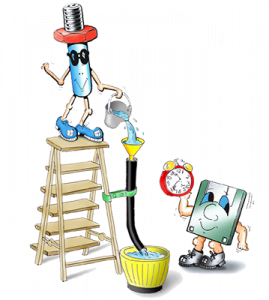 If you had no flow meter and needed to get an idea of the flow rate in a hydraulic system, a crude way to measure the flow would be to time how long it takes to fill a bucket with oil. However, apart from being quite dangerous, the solution is not very practical; once the oil is inside of the bucket, it is out of circulation, exposed to contamination and no longer inside of the hydraulic system.
If you had no flow meter and needed to get an idea of the flow rate in a hydraulic system, a crude way to measure the flow would be to time how long it takes to fill a bucket with oil. However, apart from being quite dangerous, the solution is not very practical; once the oil is inside of the bucket, it is out of circulation, exposed to contamination and no longer inside of the hydraulic system.
What should you consider when selecting a flow meter?
When searching for a flow meter for use in a particular hydraulic application, these five questions can help:
1. What are the fluid properties?
2. What are the hydraulic system operating conditions?
3. Why is flow being measured; how accurate does the flow measurement need to be?
4. What effect might the flow meter have on the fluid and vice-versa?
5. How important is it to measure flow; what is your budget?
1. What are the fluid properties?
First of all, is the flow meter going to be used on the same fluid all of the time?
It is important to know about the fluid(s) being measured, as the characteristics of the fluid can greatly influence the choice of flow meter. Of particular interest are the fluid properties: Is it corrosive or a natural lubricant, and what is its material compatibility and viscosity characteristics?
Fluid viscosity
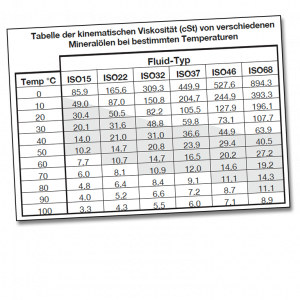 As the temperature of hydraulic oil increases, the kinematic viscosity goes down. The effect of the change in oil viscosity will affect some flow meter technologies more than others.
As the temperature of hydraulic oil increases, the kinematic viscosity goes down. The effect of the change in oil viscosity will affect some flow meter technologies more than others.
2. What are the hydraulic system operating conditions?
Most importantly what are the maximum and minimum flows you need to measure, the maximum operating pressure and the ambient and system temperature range?
Lastly, you also need to know the system’s typical cleanliness level, especially if the system isn’t very clean, as some flow meters are more sensitive to contamination.
3. Why are you measuring flow; how accurately do you need to measure flow?
For some applications, flow measurement is required to monitor trends, such as answering the question of whether ‘the flow is more or less than last week’. At other times, flow measurement is required to compare performance with other systems or against a manufacturer’s specification.
Flow meter accuracy
Accuracy is normally quoted by the flow meter manufacturer as a percentage value to indicate the acceptable error band. This should be traceable and be based on when the flow meter was last calibrated and carried out under the conditions stated by the manufacturer. Typically, accuracies are quoted as a percentage of either side of the ‘maximum’ or ‘full-scale’ value or as a percentage of either side of the ‘measured’ or ‘indicated’ reading.
4. What effect might the flow meter have on the fluid and vice-versa?
This ‘effect’ can be measured by the energy loss due to the presence of the meter, better known as the pressure drop (∆P) across the device. This has two effects: Increasing the upstream pressure and generating heat.
5. How important is it to measure flow; what is your budget?
A better question might be, ‘What happens if you don’t measure flow?’ If the answer is ‘nothing; it’s just one of many indicators we look at’, then you already know that you’re working with a very small budget. However, if the answer is, ‘the PLC will think that the machine lubrication has failed and stopped working’, then you know how much you might budget to stop that from happening.
The most common types of hydraulic flow meter
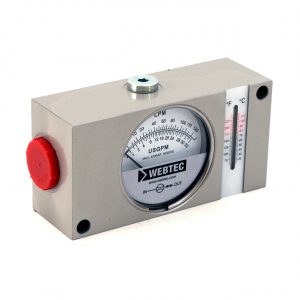
Variable orifice flow meter
Variable orifice flow meters
The idea of flow displacing an object, usually a piston or a ring, forms the basis of simple ‘variable orifice’ flow meters. The momentum of the fluid exerts a force on a piston that is held in place by a spring. Such meters typically have an accuracy of between 2 – 5% of full scale.
Gear type flow meters
These are positive displacement flow meters. On the inside, they look similar to a gear-type motor. Fluid passes around the outside of a pair of intermeshed gears, rotating the gears on their shafts. A transducer mounted above one of the gears generates a pulse each time a gear tooth passes under it. The rotation of the gears is proportional to the flow rate. Sometimes, two transducers are used to measure direction and improve resolution.
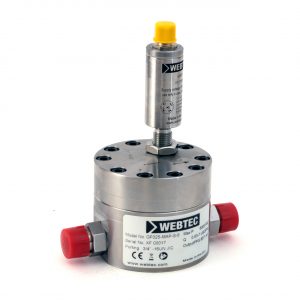
Gear type flow meter
Turbine-type flow meters
In a turbine-type flow meter, a turbine rotor is mounted on a shaft between two sets of flow straighteners. The fluid passes through the flow meter and rotates the turbine blade. As for a gear-type flow meter, a transducer is mounted above the turbine and generates a pulse each time a blade passes under it. The frequency from the transducer is proportional to the flow over a limited range.
Other meter types
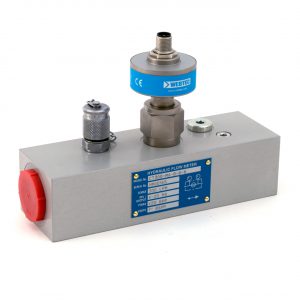
Turbine-type flow meter
Oval gear meters are similar to conventional gear meters, but use two elliptical gears that rotate together at 90º to one another inside a housing. The fluid is swept around the chamber by the gears, and the frequency of rotation is directly related to the volume of fluid through the meter.
Webtec
www.webtec.com
Filed Under: Sensors & Gauges